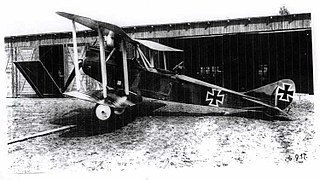Related Research Articles

Friedrichshafen FF.49 was a German, two-seat, single-engine float-plane designed by Flugzeugbau Friedrichshafen in 1917.

The LVG C.VI was a German two-seat reconnaissance and artillery spotting aircraft used during World War I.

The Pfalz D.VIII was a German World War I fighter aircraft.
The Friedrichshafen FF.43 was a German single-seat floatplane fighter of the 1910s produced by Flugzeugbau Friedrichshafen.
The Friedrichshafen FF.48 was a German two-seat floatplane fighter of the 1910s produced by Flugzeugbau Friedrichshafen.

The Rumpler C.IV was a German single-engine, two-seat reconnaissance biplane. It was a development of C.III with different tail surfaces and using a Mercedes D.IVa engine in place of the C.III's Benz Bz.IV. The Rumpler 6B 2 was a single-seat floatplane fighter variant with a 120 kW (160 hp) Mercedes D.III engine built for the Kaiserliche Marine.

The Hansa-Brandenburg W.19 was a German fighter-reconnaissance aircraft of World War I. It was a single-engined two-seat biplane floatplane, and was a larger development of the successful W.12. It served with the Kaiserliche Marine during 1918.

The Gotha WD.14, WD.20, and WD.22 were a family of biplane torpedo bomber floatplanes developed in Germany during World War I.

The LVG C.II was a 1910s German two-seat reconnaissance biplane designed at the Luft-Verkehrs-Gesellschaft for the Luftstreitkräfte.

The LVG C.V was a reconnaissance aircraft produced in large numbers in Germany during World War I.

The Zeppelin-Lindau CS.I was a German single-engined reconnaissance seaplane with a low-wing monoplane layout.
The Aviatik C.IX was a prototype German observation aircraft built by Aviatik in the final months of World War I.
The Aviatik C.VIII was a prototype German observation aircraft built by Aviatik in World War I.
The Germania C.I was a prototype two-seat general-purpose biplane built by Halberstadt during World War I.
The Halberstadt C.VIII was a prototype two-seat general-purpose biplane built by Halberstadt during World War I.
The LVG D.III was a German fighter plane built by LVG in World War I.
The LVG D.IV was a German fighter plane built by LVG in World War I.
The LVG D.VI was a prototype German biplane fighter built by LVG in World War I.
The Daimler CL.I was a prototype two-seat fighter built in Germany during World War I.
The Hansa-Brandenburg W.25 was a German floatplane fighter of the World War I era, designed and built by Hansa-Brandenburg.
References
- ↑ Taylor, Michael J. H. (1989). Jane's Encyclopedia of Aviation. London: Studio Editions. p. 615.
- ↑ Gray, Peter; Thetford, Owen (1970). German Aircraft of the First World War (2nd ed.). London: Putnam. p. 477. ISBN 0-370-00103-6.